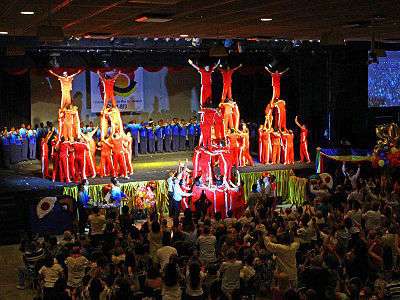Gymnastic formation

Gymnastic formation is a collective art based on gymnastic expressed by 30 to 5000 figurants using only human bodies without instruments. It is commonly presented in Japanese schools as a part of physical education curriculum. The expression of the collective beauty based on force, passion, and union of young men is much more important than the individual expression. It is a modality of mass game.
In this moment, there is no unified English expression. In the United States of America, journalists sometimes use the expression “mass gymnastics” especially to represent annual festival of the North Korea. However, this expression not always includes mounting, and therefore, it meaning is similar to mass game. In the other English speaking countries, such as Malaysia, it is called “gymnastic formation”. In Japan, it is called “kumi-taisô”, which means mounting gymnastics.
History
Basic performances of gymnastic formation are seen at the wall painting of ancient Egypt and ceramic art of ancient China. In the Middle Age of Europe, it was exhibited in Italy on the festivities. In the 19th century, gymnastic formation was performed in Germany. In the beginning of the 20th Century, in the United States of America, some young women’s groups performed it. In Czechoslovakia (country name of that time), large-scale gymnastic formation of thousands of figurants was exhibited up to 1985. In Japan, gymnastic formation of hundreds of figurants is performed up to the present in annual sports festival of schools. Up to the end of the 20th century, gymnastic formation was practiced in many organizations of the world. However, in the 21st century large-scale gymnastic becomes less exhibited. Today, it is seem in limited countries and territories, such as Hong Kong, Malaysia, Brazil, Philippines, and North Korea. The former four are civil events and the latter is a national governmental event.
Performance





Gymnastic formation has general objective of demonstration of force, passion, and union of the participants and not a modality to dispute championship. General flow is from small-light mounting to large-heavy mounting. The performance of the NGOs, such as the SGI, is widely variable, such as, bi-dimensional wave, sky rocket, windmill, walking wall, walking pyramid, catapult, instantaneous stand-up pyramid, instantaneous stand-up tower, three-layers' plane tower, four-layers' tower, and rarely five-layers' tower. The six-layers' tower that stood up in Osaka, Japan, in 1982 was indexed on the Guinness Book.
Bibliographic references
- Yasuichi Hamada, 1996. Ilusstrated gymnastic formation. Daishûkan Edition, 305p. ISBN 978-4-469-26349-7 (in Japanese, 浜田靖一 『イラストで見る組体操・組立体操』)
- Yasuich Hamada, 1998. Illustrated and photographed mass games. Daishukan Edition, 268p. ISBN 4-469-26384-2 (in Japanese, 浜田靖一 『イラストと写真で見るマスゲーム』)
See also
- Castells, human towers built in Catalonia
- Govinda sport, human towers built in India